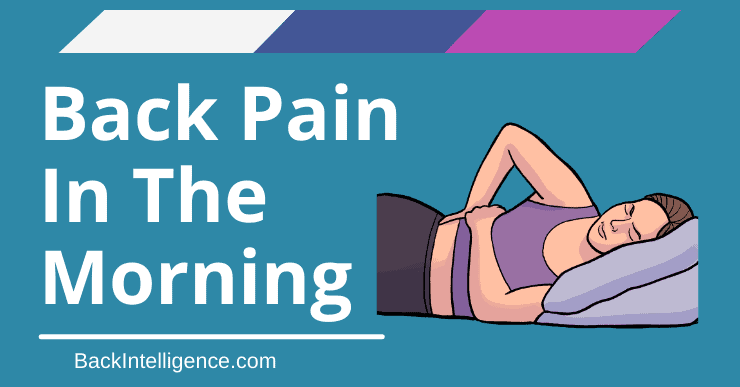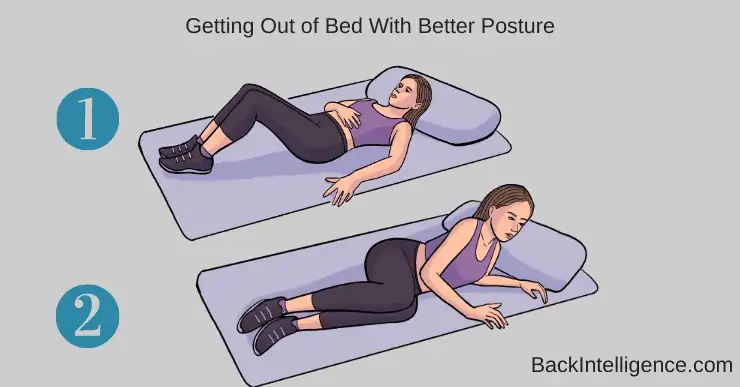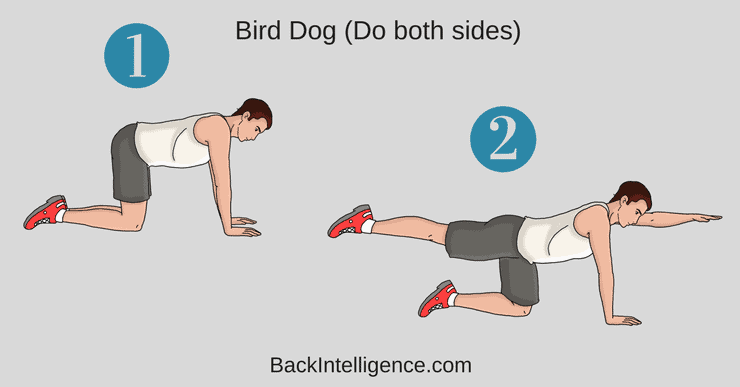
Tired of waking up with back pain? You are not alone. Studies report that 80% of people will have low back pain sometime during their lifetime.[1][2][5]
Back pain in the morning is very common and is often felt right upon getting up from bed. There are many reasons for it, but one of the main ones is that in the morning there is not enough blood flow to your joints and muscles – which results in stiffness.
Eventually the pain and stiffness subside as you start moving around and blood flow improves throughout the body. Below we also have specific things that will help you to decrease morning back pain.
Common Causes of Morning Back Pain:
- Sleeping Positions
- Quality of Mattress
- Lack of Sleep
- Low quality or not enough sleep can make you more susceptible to pain
- Inflammation
- Degenerative Disc Disease[5]
- Worse in the morning due to increased pressure inside the disc that puts pressure on the nerves
- Pregnancy can cause lower back muscle strains
- Most common during 5th-7th month of pregnancy but can happen as early as 8 weeks.
- Stress and Depression[5]
- Facet Joint Syndrome AKA Arthritis of the Spine
- Facet Joint Pain is more obvious in the morning.[5]
- Fibromyalgia
- Can affect how your brain processes pain therefore intensifying it.
- Spinal Stenosis[5]
- Can be made worse by certain sleeping positions
- Herniated Discs[5]
Symptoms of Morning Back Pain:
- Back Pain
- Pain may radiate down into leg
- Stiffness
Sometimes the things you do right before going to bed and during, can make a difference. For more on this check out our article: 7 tips of how to sleep with low back pain.
What Can Be Done About Morning Back Pain?
Back pain typically goes away within a few weeks without any formal treatment, but chronic back pain lasts 12 weeks or longer and does not always respond to treatment.[3]
#1 Change Sleeping Position
- People sleep an average of 8 hours per night. If you think about it that’s one third of your day that your body isn’t really moving. Body position and comfort are vital.
- Do not sleep on your stomach. Sleeping on your stomach can affect the natural curvature in your spine.
- You should sleep on either your back or side.
- When sleeping on your side you should place a pillow between your legs to help align hips and ensure proper curvature. It also helps to prevent rolling around in your sleep.
- When sleeping on your back place a pillow under your knees or a rolled-up towel in the small of your back to help ensure proper curvature.
- If you are not able to change sleeping position and must sleep on your stomach place a pillow under your hips for support to help take pressure off your back.
#2 Get a New Mattress
- If you have had your mattress for more than 10 years it may be time to consider replacing it.
- Quality of mattress can be determined by thickness, firmness, preferred sleeping position and your weight.
- It is recommended that you choose a medium-firm mattress, rather than something that is too firm or too soft.
- You want to avoid putting pressure on your shoulders or sacrum (your bottom)
The Complete Posture Fix (With Dr. Oliver)
Fix your Rounded shoulders & Fwd Head posture, get out of pain and increase your mobility.
Learn More
#3 Stretch Before Getting Out of Bed
Single knee to chest
- Lie on your back in a relaxed position.
- Take both of your hands and place them on the back of one of your thigh (above your knee).
- Gently bring one knee up towards your chest while leaving the other knee straight resting on the mattress.
- Hold this position for 10-15 seconds then relax.
- Repeat on the other side.
- Complete 3x on each leg.
Child’s Pose
- Begin by positioning yourself on the floor on your hands and knees with your knees slightly wider than your hips.
- Turn your toes inwards to touch and push your hips backwards while bending your knees.
- Once you’re in a comfortable position, straighten your arms forward and allow your head to fall forwards into a relaxed position.
- Hold this position for 15 to 20 seconds.
- Slowly return to the starting position.
- Aim for 3 repetitions
Related Article: Stretches for Lower Back Pain
#4 Get Out of Bed Properly
- Don’t get up too quickly
- Move to the edge of your bed and roll over onto your side.
- Push down with arms on the bed to move into a seated position while dropping your legs off the side of the bed. This will prevent twisting of your spine.
- Scoot to the edge of the bed and lean your weight forward to stand up. This will encourage you to use your legs to stand up rather than your back.
#5 Take a Warm Shower
- Relax muscles and promote circulation
- You can do this immediately after waking up
#6 Exercises After getting up
Cat & Cow Stretch
- Begin this stretch on your hands and knees.
- Inhale, arch your low back (from pelvis) and let your stomach “drop” towards the floor as you look up towards the ceiling.
- Exhale and slowly round your spine while pressing into the floor with your hands and slightly curving your neck to look at your feet (curve your back).
- Aim for 10 repetitions of this stretch.
Prone Y Extensions
This exercise is done for scapular stabilization and strengthening your back.
- Can be done off the side of a bed or while lying on your stomach on a large exercise ball with arms hanging straight down.
- Raise your arms up to a 45-degree angle (with thumbs up), making a Y between your arms and body. Only raise arms up to shoulder height.
- Now lower arms to starting position
- Build up to 2x 10
** Careful not to arch your low back as you lift your arms.
** Do not shrug your shoulders
Bird Dog
This is a great exercise to improve core strength and lumbar back muscles.
How to do it:
– Begin on your hands and knees, with your hands positioned under your shoulders and knees positioned under your hips.
– Brace (contract) your core as hard as you can before beginning any movement.
– While bracing your core, raise your left arm and reach it forwards until it is aligned with your torso; at the same time, kick your right leg backwards until is it aligned with your torso.
– It’s important to not arch your low back as you do this.
– Hold this position for 2-3 seconds before slowly returning to the starting position.
– Repeat with your right arm and left leg.
– Alternate sides for 10 repetitions.
** Only extend your arm and leg to where it’s comfortable and don’t arch your low back.
#7 Walking
Walking is a great activity in the morning for engaging your muscles and loosening your joints. The key is to walk at a pace that is comfortable for you and doesn’t cause you more pain.
Learn More
Related:
How To Get Rid of Tension Headaches (Plus Causes & Symptoms)
What is a chiropractic adjustment?
7 Stretches for Lower Back Pain
Is Walking Good For Lower Back Pain?
Lower Back Pain When Sitting? Causes & Treatment Options
Sources:
[1] Alsaadi SM, McAuley JH, Hush JM, et al. Prevalence of sleep disturbance in patients with low back pain. Eur Spine J. 2011; 20(5): 737-743 doi:10.1007/s00586-010-1661-x.
[2] Dunsford A, Kumar S, and Clarke S. Integrating evidence into practice: use of McKenzie-based treatment for mechanical low back pain. J Multidiscip Healthc. 2011;4: 393-402. doi: 10.2147/JMDH.S24733
[3] Casazza BA. Diagnosis and treatment of acute low back pain. Am Fam Physician. 2012; 85 (4): 343-350.
Doctor of Physical Therapy and currently works full time as a pediatric physical therapist. Rachel has worked in Sports, Inpatient Rehab and Outpatient Ortho settings under the guidance of incredible mentors focusing on low back pain. Rachel believes in holistic and patient centered care and enjoys developing their course of treatment.












